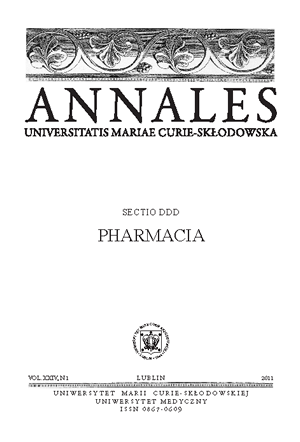Cyclosporine A nephrotoxicity: Role of oxidative stress
Keywords:
Cyclosporine A, nephrotoxicity, oxidative stress, mitochondriaAbstract
Cyclosporine A (CsA) is a calcineurin inhibitor which has remained for many years a crucial immunosuppressant with a major therapeutic role in a solid organ transplantation and in various immunological diseases. The main adverse effect of CsA is nephrotoxicity. Cs-A induced kidney dysfunction and morphological damage has multifactorial pathogenesis. The renin-angiotensin system, endothelin and eicosanoids have been considered as potential mediators of CsA-related kidney dysfunction. Recently oxidative stress and reactive oxygen species (ROS) release have been proposed as an alternate source of CsA-dependent kidney damage. CsA nephrotoxicity is associated with imbalanced red-ox state and oxidative stress in renal tubular, endothelial and glomerular cells. CsA-induced ROS release in the kidney is accompanied be development of morphologic changes including vascular injury with ischemic damage, interstitial fibrosis, progressive glomerular sclerosis, tubular atrophy and cell apoptosis.
References
1. Akool E.S. at al.: Molecular mechanisms of TGF beta receptor-triggered signaling cascades rapidly induced by the calcineurin inhibitors cyclosporin A and FK5061. J. Immunol., 181, 2831, 2008.
2. Amore A., Emancipator S.N., Cirina P.: Nitric Oxide mediates cyclosporine-induced apoptosis in cultured renal cells. Kidney Int., 57, 1549, 2000.
3. Amudha G., Josephine A., Varalakshmi P.: Role of lipoic acid in reducing the oxidative stress induced by cyclosporine A. Clin. Chim. Acta, 372, 134, 2006.
4. Anjaneyulu M., Tirkey N., Chopra K.: Attenuation of cyclosporine-induced renal dysfunction by catechin: possible antioxidant mechanism. Renal Fail., 25, 691, 2003.
5. Atessahin A., Ceribasi A.O., Yilmaz S.: Lycopene, a carotenoid, attenuates cyclosporine-induced renal dysfunction and oxidative stress in rats. Basic Clin. Pharmacol. Toxicol., 100, 372, 2007.
6. Burdmann E.A. et al.: Cyclosporine nephrotoxicity. Semin. Nephrol. 23, 465, 2003
7. Capasso G. et al: In vivo effect of the natural antioxidant hydroxytyrosol on cyclosporine nephrotoxicity in rats. Nephrol. Dial. Transplant., 23, 1186, 2008.
8. Damzy D. et al: Role of endothelin-1 and Nitric Oxide bioavailability in transplant-related vascular injury: comparative effects of rapamycin and cyclosporine. Circulation, 114, 214, 2006.
9. DeHornedo J.P. et al: Cyclosporin A causes oxidative stress and mitochondrial dysfunction in tubular renal cells. Nefrologia, 27, 565, 2007.
10. Hagar H.H., El Etter E., Arafa M.: Taurine attenuates hypertension and renal dysfunction induced by cyclosporine in rats. Clin. Exp. Pharmacol. Physiol., 33, 189, 2006.
11. Hakan A. et al.: Effect of Hyperbaric oxygen on cyclosporine-induced nephrotoxicity and oxidative stress in rats. Renal Failure, 29, 495, 2007.
12. Iglesias-deLaCruz M.C. et al.: Hydrogen peroxide increases extracellular matrix mRNA through TGF-β in human mesangial cells. Kidney Int., 59, 87, 2001.
13. Inselmann G., Hannemann J., Baumann K.: Cyclosporine A induced lipid peroxidation and influence on glucose-6-phosphatase in rat hepatic and renal microsomes. Res. Commun. Chem. Pathol. Pharmacol., 68, 189, 1990.
14. Jennings P. et al.: Cyclosporine A induces senescence in renal tubular epithelial cells. Am. J. Physiol. Renal Physiol., 293, 831, 2007.
15. Jeon S.H. et al.: Prednisolone supresses cyclosporine A – induced apoptosis but not cell cycle arrest in MDCK cells. Arch. Biochem. Biophys., 435, 382, 2005.
16. Josephine A. et al.: Oxidative and nitrosative stress mediated renal cellular damage induced by Cyclosporine A: Role of Sulphated Polysaccharides. Biol. Pharm. Bull., 30,1254, 2007.
17. Kim J.S., He L., Lemasters J.J.: Mitochondrial permeability transition: a common pathway to necrosis and apoptosis. Biochem. Biophys. Res. Commun., 304, 463, 2003.
18. Kowaltowski A.J., Castilho R.F., Vercesi A.E.: Mitochondrial permeability transition and oxidative stress. FEBS lett., 495, 12, 2001.
19. L’Alzou B et al.: In vitro models to study mechanisms involved in cyclosporine A-mediated glomerular contraction. Arch. Toxicol., 73, 337, 1999.
20. Navarro-Antolin J. et al.: Role of peroxynitrite in endothelial damage mediated by cyclosporine A. Free Radical Biol. Med., 42, 394, 2007.
21. Nishida M et al.: Role of hydrogen peroxide in cyclosporine-induced renal tubular cell (LLC-PK1) injury. J. Pharmacol. Sci., 91, 255, 2003
22. Parra Cid T. et all.: Antioxidant nutrients protect against cyclosporine A nephrotoxicity. Toxicology, 189, 99, 2003.
23. Raymond M.A. et al.: Blockade of the apoptotic machinery by cyclosporin A redirects cell death toward necrosis in arterial endothelial cells: regulation by reactive oxygen species and cathepsin D. Faseb J., 17, 515, 2003.
24. Rezzani R., Rodella L., Buffoli B.: Change in renal heme oxygenase expression in cyclosporine A-induced injury. J. Histochem. Cytochem., 53, 105, 2005.
25. Sonaje K. et al.: Development of biodegradable nanoparticles for oral delivery of Ellagic Acid and eveluation of their antioxidant efficacy against cyclosporine A- induced nephrotoxicity in rats. Pharmaceutical Research, 24, 899, 2007.
26. Tariq M. et al.: N- Acetylcysteine attenuates cyclosporin-induced nephrotoxicity in rats. Nephrol. Dial. Transplant., 14, 923, 1999.
27. Uz E. et al.: Nigella sativa oil for prevention of chronic cycloxporine nephrotoxicity: an experimental model. Am. J. Nephrol., 28, 517, 2008.
28. Wongmekiat O., Leelarugrayub N., Thamprasert K.: Beneficial effect of shallot (Allium Ascalonicum L.) extract on cyclosporine nephrotoxicity in rats. Food and Chemical Toxicol., 46, 1844, 2008.
29. Vetter M. et al.: Cyclosporin A disrupts bradykinin signaling through superoxide. Hypertension, 41, 1136, 2003.
30. Zhong Z. et al.: Cyclosporin A causes a hypermetabolic state and hypoxia in the liver: prevention by dietary glycine. J. Pharmacol. Exp. Therapeutics, 299, 858, 2001.
Downloads
Published
Issue
Section
License
Copyright (c) 2011 Authors

This work is licensed under a Creative Commons Attribution-NonCommercial-NoDerivatives 3.0 Unported License.


